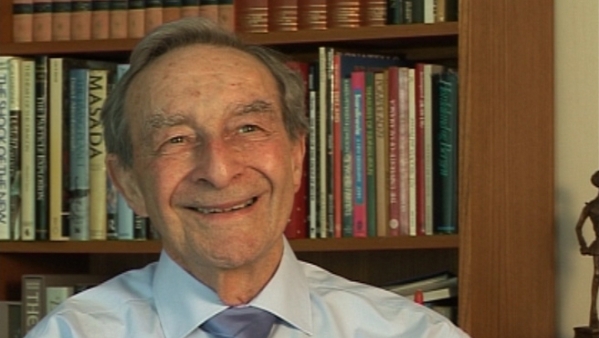NEXT STORY

Introduction to my hydride work
RELATED STORIES

NEXT STORY

Introduction to my hydride work
RELATED STORIES


|
Views | Duration | |
|---|---|---|---|
| 141. Work on inert gases | 38 | 04:26 | |
| 142. Introduction to my hydride work | 37 | 00:48 | |
| 143. Aluminium hydride | 44 | 00:48 | |
| 144. Boron hydride | 53 | 02:04 | |
| 145. Bob Parry's similar boron work | 36 | 01:11 | |
| 146. No publication restrictions on research at Newcastle | 37 | 00:38 | |
| 147. Other people's interest in hydrides | 29 | 00:53 | |
| 148. Harry Emeléus was the first to make decaborane | 41 | 00:47 | |
| 149. Motivation for working on gallium hydride | 57 | 01:02 | |
| 150. Making gallium hydride | 44 | 00:56 |


So, with Ernest Aynsley’s background in preparative fluorine chemistry, and with Jim Smith’s help, and my own background, and people like Malcolm Wallbridge, we soon got a very productive group going.
But what did we work on? One thing, and we’ve mentioned it already, is inert gas compounds. Before Neil Bartlett did his world changing experiments in Vancouver in 1961 – and it was a beautiful experiment that he did to make the first compound of xenon, an inert gas – I’d been thinking that inert gases had a lot of lone pairs of electrons, the ionisation potentials of these electrons are very similar to some of the compounds that we were studying, I wonder if they would form a compound. I was beginning to become familiar with making and breaking of one bond at a time, and I knew from our work on thermochemistry – and counter intuitively – that boron trifluoride is in fact the weakest of the acceptors of the group. Trichloride, tribromide, triiodide are actually better acceptors but they don’t form coordination compounds normally, because they have weaker bonds than boron fluoride, which the very strength of the boron fluorine bond when you have to reorganise it from planar to a tetrahedral that makes it the weakest. Chlorine doesn’t take so much effort to reconfigure, so it should be a better acceptor. But unfortunately the boron-chlorine bond being weaker, it will then solvolyse so if you try and form an etherate, you form an ethoxide, and you start chlorinating the compound. So it’s a trade off there. But, of course, xenon and the other inert gases don’t have any groups attached, so I thought maybe they would join on. Now there’d been a little bit of work on argon, which in my view would not have been the one to start from, but the Munich group had started work on this, I think a decade or so earlier. And there were some suggestions that there were some compounds there, but I think later work had discounted that to be so. But to cut a long story short, we looked at that by sealing up all of the group three trihalides with various inert gases under pressure, and you recall from earlier things I was used to working under pressure as well, but in fact the idea didn’t work out for ideas… for reasons which I think we now understand. It was worth a try, but it was a good idea which didn’t work out. But I think you have a memory of the phials which we had... we’d clearly two layers, liquid boron trichloride or tribromide and liquid xenon under pressure, or liquid, I think, xenon and…
[Q] Absolutely, Norman, I remember it so very well.
...krypton I think we did as well. That was an interesting experiment – it didn’t work. We also tried seeing if helium, was unduly soluble in sulphuric acid and phosphoric acid as well, to see if that would hydrate the proton or solvate the proton – that didn’t work out either. But we were working round these areas. Pete Perkins, as I mentioned was doing the thermochemistry side going theoretical . We also had an X-ray crystallographer in the group, Alan Hazell, who later went to work in Copenhagen and stayed over there at the University of Aarhus, and Hans Stadler was a crystallographer in the physical chemistry department as well.
Norman Greenwood (1925-2012) was born in Australia and graduated from Melbourne University before going to Cambridge. His wide-ranging research in inorganic and structural chemistry made major advances in the chemistry of boron hydrides and other main-group element compounds. He also pioneered the application of Mössbauer spectroscopy to problems in chemistry. He was a prolific writer and inspirational lecturer on chemical and educational themes, and held numerous visiting professorships throughout the world.
Title: Work on inert gases
Listeners: Brian Johnson
Professor Brian FG Johnson FRS, FRSE, FRS Chem, FAcad Eu, FAS. Professor of Inorganic Chemistry University of Edinburgh 1991-1995, Professor of Inorganic Chemistry University of Cambridge 1995-2005, Master Fitzwilliam College Cambridge 1999-2005. Research interests include studies of transition metal carbonyls, organometallic chemistry, nano- particles and homogeneous catalysis. Professor Johnson is the author of over 1000 research articles and papers.
Tags: Vancouver, 1961, Copenhagen, Aarhus University, EE Aynsley, Jim Smith, Malcolm Wallbridge, Neil Bartlett, Peter Perkins, Alan Hazell, Hans Stadler
Duration: 4 minutes, 26 seconds
Date story recorded: May 2011
Date story went live: 25 November 2011